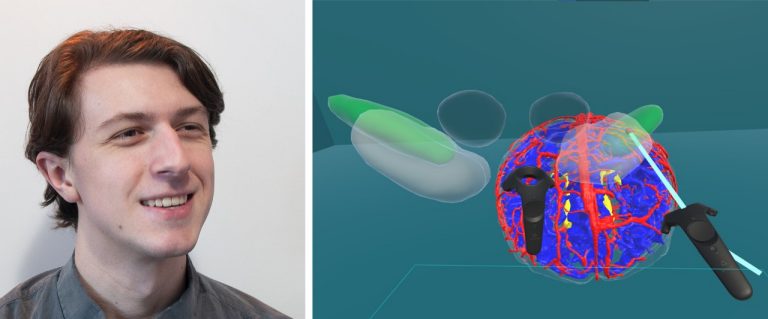Gina Cody School undergrad publishes three peer-reviewed papers, co-authored with computer science and psychology profs

Owen Hellum stands out for several reasons — not least because during his last term as a Concordia undergraduate computer science student he created SONIA. The program is the first immersive virtual reality (VR) system that integrates customizable design and detailed narratives of the brain for educational purposes.
Hellum also co-authored two publications about medical VR while at the Gina Cody School of Engineering and Computer Science.
“It’s been pretty wild to get three papers published and to have one of them be patent pending — all in the span of three years in an undergraduate program,” he says.
“The projects got more and more complex. This last one, which was educational, was quite major because I designed it to be customizable,” he adds.
“You could input whatever brain structures you wanted rather than just pre-loaded ones, making it usable by anyone in any context, theoretically.”
Hellum co-authored the peer-reviewed journal papers as part of his work at the Gina Cody School’s Health-X Lab. The papers were written in collaboration with Yiming Xiao, assistant professor in the Department of Computer Science and Software Engineering.

Marta Kersten-Oertel, assistant professor in the same department, and Christopher Steele, assistant professor of psychology, also contributed.
Xiao specializes in medical imaging. He combines techniques in medical imaging with computer vision and machine learning to improve the efficiency and accuracy of computer-assisted diagnosis and image-guided surgery.
Xiao has nothing but praise for the undergraduate student.
“Owen has consistently shown a practical and thoughtful approach in his VR research, making significant contributions to our ongoing projects,” he says. “His dedication and problem-solving skills have been a great asset to our team, reflecting the quality of work we strive for in our department.”
“SONIA: an immersive customizable virtual reality system for the education and exploration of brain networks” was co-authored in collaboration with Steele. It was published last month in the journal Frontiers in Virtual Reality.
“Assessment of user-interaction strategies for neurosurgical data navigation and annotation in virtual reality” was published in the journal Virtual Reality in 2022.
Hellum’s first paper, “A novel prototype for virtual-reality-based deep brain stimulation trajectory planning using voodoo doll annotation and eye-tracking,” was published in Computer Methods in Biomechanics and Biomedical Engineering: Imaging & Visualization in 2021.
The publications are the result of Hellum’s involvement in the Concordia Undergraduate Student Research Awards (CUSRA) program.
“CUSRA is huge for undergraduate students who want to get a lens into what it’s like in the graduate world. It was the seed that started it all,” Hellum notes.
“The program been enormously useful for me. It introduces you to more scholars and is the bridge that connects the university to other places, like jobs or higher education.”

In addition to his involvement with the Health-X Lab, Hellum is also part of the Technoculture, Arts and Games (TAG) Lab at Concordia. TAG is an interdisciplinary centre for research-creation in game studies and design, digital culture and interactive art. It’s also Canada’s largest games research institute.
Hellum has worked on various independent and collaborative game projects and is currently weighing what to do next. “I’m sort of itching to get into the industry, but we’ll see,” he says.
Hellum, who’s originally from Ontario, says he moved to Montreal because of its reputation as a game city. He also shares that he was attracted by Concordia’s unique Computer Science – Computation Arts program.
“I figured that if I came here, it would be a good foundation for a lot of places. The papers are actually an example of how that worked out,” he says.
“The program is half computer science and half computation arts, and it’s the only program that I’ve ever seen that offers both. It’s all the weird stuff together — a melting pot of creativity.”
Read the cited papers:
Discover Concordia’s Department of Computer Science and Software Engineering.
Learn more about the Concordia Undergraduate Student Research Awards Program.


